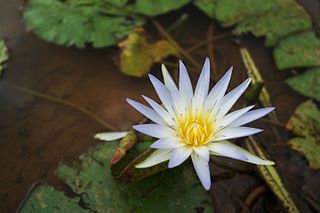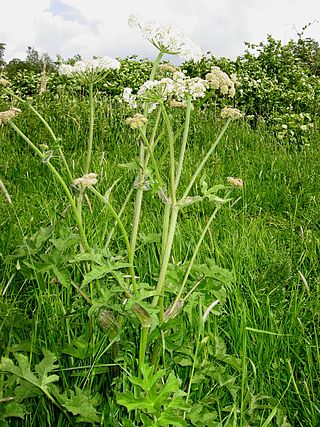
Royal Botanic Gardens, Kew is a non-departmental public body in the United Kingdom sponsored by the Department for Environment, Food and Rural Affairs. An internationally important botanical research and education institution, it employs 1,100 staff. Its board of trustees is chaired by Dame Amelia Fawcett.

Nymphaea nouchali var. caerulea, is a water lily in the genus Nymphaea, a botanical variety of Nymphaea nouchali.

Heracleum sphondylium, commonly known as hogweed or common hogweed, is a herbaceous perennial plant in the carrot family Apiaceae, which includes fennel, cow parsley, ground elder and giant hogweed. It is native to most of Europe, western Asia and northern Africa, but is introduced in North America and elsewhere. Other common names include cow parsnip or eltrot. The flowers provide a great deal of nectar for pollinators.

Heritiera littoralis, commonly known as the looking-glass mangrove or tulip mangrove, is a mangrove tree in the family Malvaceae native to coastal areas of eastern Africa, Asia, Melanesia and northern Australia. The common name refers to the silvery appearance of the underside of the leaves, resembling a mirror to some degree. The strong timber has uses in marine applications and elsewhere.

Neolitsea dealbata, also known as white bolly gum, hairy-leaved bolly gum, or simply bolly gum, is a shrub or small tree in the laurel family Lauraceae which is native to New South Wales and Queensland in Australia.
Erythrina schliebenii is a species of legume in the family Fabaceae. It is found only in Tanzania. The species is named for German collector and botanist Hans-Joachim Schlieben.
Euphorbia rubrostriata, synonym Euphorbia mainiana, is a species of plant in the family Euphorbiaceae. It is endemic to Madagascar. Its natural habitats are subtropical or tropical dry shrubland and rocky areas. It is threatened by habitat loss.

Bernard Verdcourt was a biologist and taxonomist, most widely known as a botanist and latterly an honorary research fellow at the Royal Botanic Gardens, Kew in London. Prior to coming to Kew in 1964, he was associated with the East African Herbarium for 15 years. Although his best-known work probably consists of his many studies of the East African flora, he has also made extensive contributions relating to African terrestrial mollusks and to entomology. Dr. Verdcourt received the Linnean Medal for botany from the Linnean Society of London in 2000. His list of publications includes more than 1,000 scientific works. The standard author abbreviation Verdc. is used to indicate this person as the author when citing a botanical name.

Nymphaea thermarum is a species of water lily that is endemic to Rwanda. Once thought to be extinct in the wild, all wild plants were believed to be lost due to destruction of its native habitat, but it was thought to be saved from extinction when it was grown from seed at the Royal Botanic Gardens, Kew in 2009. A previously-unknown wild population was discovered in 2023.

Phyllanthus microcladus, commonly known as the brush sauropus or small-leaved Phyllanthus, is a plant in the family Phyllanthaceae found in tropical and sub tropical areas of eastern Queensland and northeastern New South Wales in Australia. It is listed as endangered in New South Wales, but in Queensland it is assessed as least concern. It occurs by streams in rainforest, from near Grafton northwards to around Cairns.
The Plant List was a list of botanical names of species of plants created by the Royal Botanic Gardens, Kew and the Missouri Botanical Garden and launched in 2010. It was intended to be a comprehensive record of all known names of plant species over time, and was produced in response to Target 1 of the 2002–2010 Global Strategy for Plant Conservation, to produce "An online flora of all known plants". It has not been updated since 2013, and has been superseded by World Flora Online.

Suaeda vera, also known as shrubby sea-blite, shrubby seablight or in the USA sometimes as alkali seepweed, is a species of flowering plant in the family Amaranthaceae. It is a small shrub, with very variable appearance over its wide range. It is a halophyte, and occurs in arid and semi-arid saltflats, salt marshes and similar habitats.

Lumnitzera racemosa, commonly known as the white-flowered black mangrove, is a species of mangrove in the family Combretaceae. It is found on the eastern coast of Africa and other places in the western Indo-Pacific region. It has one accepted variety from the noniminate species, Lumnitzera racemosa var. lutea (Gaudich.) Exell.
Plants of the World Online (POWO) is an online database published by the Royal Botanic Gardens, Kew. It was launched in March 2017 with the ultimate aim being "to enable users to access information on all the world's known seed-bearing plants by 2020". The initial focus was on tropical African Floras, particularly Flora Zambesiaca, Flora of West Tropical Africa and Flora of Tropical East Africa.
Agelanthus uhehensis is a species of hemiparasitic plant in the family Loranthaceae, which is native to Tanzania.
Tropical Important Plant Areas (TIPAs) is a programme established by the Royal Botanic Gardens, Kew in 2015 in collaboration with Plantlife International, to provide a framework to identify sites important for preserving plant diversity in tropical countries. The programme is based on the Important Plant Areas (IPAs) framework set up by Plantlife International. The IPA criteria were modified to take into account the high plant richness, the limited availability of data and the higher dependence on socio-economically important yet native plants for livelihoods in the tropics. The framework acknowledges the practical problems of gathering plant and habitat data in many regions of the world, and it recognises the important role of peer reviewed expert opinion in the selection process. TIPAs can be identified based on a range of organism groups within the plant and fungal kingdoms, including algae, fungi, lichens, liverworts, mosses, and wild vascular plants. The TIPAs programme focuses on critical sites for wild plant populations. It aims to identify areas important for the conservation of threatened plants and/or habitats and areas with exceptional plant richness, and to raise awareness of the importance of plant life in tropical countries, encouraging long term conservation of these areas. TIPA sites are selected based on three criteria:
Diane Mary Bridson is a British botanist.
Edgar Wolston Bertram Handsley Milne-Redhead (1906-1996) was a British botanist. He was born in Frome, Somerset, UK. Educated at Cheltenham College and Gonville and Caius College, Cambridge, he began work at the Royal Botanic Gardens, Kew in 1928. In 1930, he accepted an offer to work in the Colonial Office in Northern Rhodesia, where he collected plants for herbarium specimens. He was based at Matonchi Farm, west of Mwinilunga, North-Western Province, Zambia, near the borders of Angola and the Democratic Republic of the Congo for 4½ months. He also collected extensively near Kalene Hill. He discovered many new species, and several were named after him, including Commelina milne-redheadii Faden (Commelinaceae). In 1933, he married artist and illustrator Olive Shaw, with whom he had one daughter.